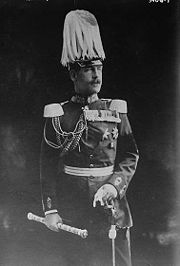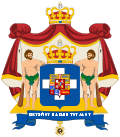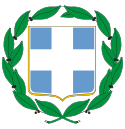Constantine I of Greece
| Constantine I | |
|---|---|
| King of the Hellenes | |
 |
|
| King of the Hellenes | |
| 1st Reign 2nd Reign |
18 March 1913 - 11 June 1917 19 December 1920 - 27 September 1922 |
| Predecessor | George I Alexander |
| Successor | Alexander George II |
| Consort | Sophie of Prussia |
| Issue | |
| George II Alexander I Helen Paul Irene Katherine |
|
| Royal house | House of Schleswig-Holstein-Sonderburg-Glücksburg |
| Royal motto | Ισχύς μου η Αγάπη του Λαού. ("The people's love, is my strength.") |
| Father | George I of Greece |
| Mother | Olga Constantinovna of Russia |
| Born | 2 August 1868 Athens, Greece |
| Died | 11 January 1923 (aged 54) Palermo, Italy |
| Burial | 22 November 1936 Royal Cemetery, Tatoi Palace, Greece |
Constantine I, King of the Hellenes (Greek: Κωνσταντίνος A', Βασιλεύς των Ελλήνων; 2 August [O.S. 21 July] 1868 - 11 January 1923) was King of Greece from 1913 to 1917 and from 1920 to 1922. He was Commander-in-Chief of the Hellenic Army during the unsuccessful Greco-Turkish War of 1897 and led the Greek forces during the successful Balkan Wars of 1912-1913, in which Greece captured Thessaloniki, and doubled in area and population. He succeeded to the throne of Greece on 18 March 1913, following his father's assassination.
His disagreement with Eleftherios Venizelos over whether Greece should enter World War I led to the National Schism. Constantine forced Venizelos to resign twice, but in 1917 he abdicated, after threats of the Entente forces to bombard Athens; he left the Crown to his second son, Alexander. After Alexander's death, Venizelos' defeat in the 1920 legislative elections, and a plebiscite in favor of his return, Constantine reassumed his duties as King. Constantine abdicated the throne for the second and last time in 1922, when Greece lost the Greco-Turkish War of 1920-1922. He was succeeded by his eldest son, George II.
Contents |
Early life
Born on 2 August 1868 in Athens, and baptized on 12 August, Constantine was the eldest son of George I of Greece (born Prince Vilhelm of Denmark) and Grand Duchess Olga Constantinovna of Russia. He had as teachers some of the most prominent university professors of the time: Ioannis Pandazidis taught him Greek literature; Vassilios Lakonas mathematics and physics; Constantine Paparrigopoulos history, infusing to the young Crown Prince the principles of Megali Idea. On 30 October 1882 he enrolled in the Hellenic Military Academy. After completing the Academy's program, he was sent to Berlin for further military education, and served in the Imperial Guard. Constantine also studied political science in Heidelberg and Leipzig. In 1890 he became Major General, and assumed the command of the headquarters of the Hellenic Army in Athens (3ο Αρχηγείο Στρατού).[1]
Confrontations with Trikoupis
In January 1895, Constantine caused a political turmoil, when he ordered the army and gendarmerie forces of Athens to dissolve a manifestation against the tax policy of the government; he had previously discussed with the crowd and advised it to submit its requests to the government. Prime minister Charilaos Trikoupis asked from the King to recommend to his son to avoid such interventions in the political life of the country without prior consultation with the government. King George responded that the Crown Prince just fulfilled his military duties, and his decision had no political importance. The incident caused a heated debate in the Parliament, and Trikoupis finally resigned. In the following elections Trikoupis was defeated, and the new prime minister, Theodoros Deligiannis, regarded the incident as closed; he did not want to preserve the atmosphere of hostility between the government and the royal family.[2]
The organization of the first modern Olympics in Athens was another issue causing a Constantine-Trikoupis confrontation; after Deligiannis' electoral victory in 1895 the pro-Olympic movement prevailed.[3] Constantine was instrumental in the organization of the 1896 Summer Olympics; according to Pierre de Coubertin, in 1894 "the Crown Prince learned with great pleasure that the Games will be inaugurated in Athens." Coubertin assured that "the King and the Crown Prince will confer their patronage on the holding of these games." Constantine later conferred more than that; he eagerly assumed the presidency of the 1896 organizing committee.[4] At the Crown Prince's request, wealthy businessman George Averoff agreed to pay for the restoration of the Panathinaiko Stadium, donating c. one million drachmas.[5]
Ascension of throne and World War I

-
For more details on this topic, see National Schism.
He succeeded to the throne of Greece on 18 March 1913 following his father's assassination in Salonica by Alexander Schinas, Greek anarchist (born in Volos, Greece 1870). Constantine was faced with the difficulty of determining, officially, where Greece's support lay once war was under way. This was complicated by the fact that his government, led by Eleftherios Venizelos, was pro-Allied and the fact that the Entente Powers were the dominant naval power in the Mediterranean.
Constantine's sympathies emerged during the Allies' disastrous Battle of Gallipoli. Despite popular support of Venizelos amongst the people and his clear majority in Parliament, Constantine disagreed with Venizelos's increasing support for the Allies. In October 1915, Venizelos resigned as Prime Minister after the two of them had argued over the shape of future policy. In his place Constantine appointed Alexandros Zaimis at the head of a short-lived coalition government.
In July 1916 arsonists set fire to the forest surrounding the royal palaces at Tatoi. Although injured in the escape, the King and his family managed to find refuge. The flames spread quickly in the dry summer heat, and sixteen people were killed.[6]
The Allied Commander in Greece, French General Maurice Sarrail, was extremely high-handed and disdainful of King Constantine. By threats and intimidation he forced the Greeks to demobilize their army (in mid-1916) and then forced them to remove all their troops to the south of the country in early 1917. Venizelos went to Thessalonica where, with the support of General Sarrail, he established a provisional revolutionary government. With civil war apparently imminent, Constantine sought from Germany firm promises of naval, military and economic assistance - without success.
Early in 1917, General Sarrail ordered the Greek army to move to the south of the country. He also ordered the Greek fleet to join the Allies and finally, Sarrail ordered the Greek government to adopt a more friendly attitude towards the Allies. In the face of the large Allied army in Greece, King Constantine abdicated the throne in favour of his second son Alexander. The Allied Powers were opposed to Constantine's first son, George, becoming King as he had served in the German army before the war and was identified with his father's pro-Central policies.[7] Constantine left Greece for exile in Switzerland on 11 June 1917. General Sarrail was himself removed in November 1917 and replaced by a more diplomatic French General. Civil war in Greece was avoided.
Return to Greece and second exile
King Alexander died 25 October 1920 and the following month Venizelos suffered defeat in a general election. Following a plebiscite, in which nearly 99% of votes were cast in favor of his return,[8] Constantine returned as king on 19 December 1920.
Within two years his popularity was lost. The Greco-Turkish War of 1920-1922 proved disastrous for the Greeks, as the Turks regained their former territory in Anatolia and Smyrna. He abdicated the throne again on 27 September 1922 and was succeeded by his eldest son, George II.[9]
He spent the rest of his life in exile in Italy and died in 1923 at Palermo, Sicily.
Marriage and issue
House of Oldenburg (Glücksburg branch)| |
|---|
| Constantine I |
| Children |
| George II |
| Alexander |
| Helen, Queen Mother of Romania |
| Paul |
| Irene, Duchess of Aosta |
| Princess Katherine |
Constantine and Princess Sophie of Prussia married on 27 October 1889 in Athens. They had six children:
Issue
| Name | Birth | Death | Notes |
|---|---|---|---|
| George II, King of the Hellenes | 20 July 1890 | 1 April 1947 | married Princess Elisabeth of Romania |
| Alexander I, King of the Hellenes | 1 August 1893 | 25 October 1920 | married Aspasia Manos |
| Princess Helen of Greece and Denmark | 2 May 1896 | 28 November 1982 | married Carol II, King of Romania |
| Paul, King of the Hellenes | 14 December 1901 | 6 March 1964 | married Princess Frederika of Hanover |
| Princess Irene of Greece and Denmark | 13 February 1904 | 15 April 1974 | married Prince Aimone of Savoy, 4th Duke of Aosta |
| Princess Katherine of Greece and Denmark | 4 May 1913 | 2 October 2007 | married Richard Brandram |
Ancestors
| Ancestors of Constantine I of Greece | ||||||||||||||||||||||||||||||||||||||||||||||||||||||||||||||||||||||||||||||||||||||||||||||||||||||||||||||||||||||||||||||||||||||||||||||||||||||||||||||||||||||||||||||||||||||||||||||||||||||||||||||||||||||||||||||||||||||||||||||||||||||||||||||||||||||||||||||||||||||||||||||||||||||||||||||||||||||||||||||||||||||||||||||||||||||||||||||||||||||||||||||||||||||||||||||||||||||||||||||||||||||||||||||||||||||||||||||||||||||||||||||||||||||||||||||||||||||||||||||||||||||||||||||||||||||||||||||||||||||||||||||||||||||||||||||||||
|---|---|---|---|---|---|---|---|---|---|---|---|---|---|---|---|---|---|---|---|---|---|---|---|---|---|---|---|---|---|---|---|---|---|---|---|---|---|---|---|---|---|---|---|---|---|---|---|---|---|---|---|---|---|---|---|---|---|---|---|---|---|---|---|---|---|---|---|---|---|---|---|---|---|---|---|---|---|---|---|---|---|---|---|---|---|---|---|---|---|---|---|---|---|---|---|---|---|---|---|---|---|---|---|---|---|---|---|---|---|---|---|---|---|---|---|---|---|---|---|---|---|---|---|---|---|---|---|---|---|---|---|---|---|---|---|---|---|---|---|---|---|---|---|---|---|---|---|---|---|---|---|---|---|---|---|---|---|---|---|---|---|---|---|---|---|---|---|---|---|---|---|---|---|---|---|---|---|---|---|---|---|---|---|---|---|---|---|---|---|---|---|---|---|---|---|---|---|---|---|---|---|---|---|---|---|---|---|---|---|---|---|---|---|---|---|---|---|---|---|---|---|---|---|---|---|---|---|---|---|---|---|---|---|---|---|---|---|---|---|---|---|---|---|---|---|---|---|---|---|---|---|---|---|---|---|---|---|---|---|---|---|---|---|---|---|---|---|---|---|---|---|---|---|---|---|---|---|---|---|---|---|---|---|---|---|---|---|---|---|---|---|---|---|---|---|---|---|---|---|---|---|---|---|---|---|---|---|---|---|---|---|---|---|---|---|---|---|---|---|---|---|---|---|---|---|---|---|---|---|---|---|---|---|---|---|---|---|---|---|---|---|---|---|---|---|---|---|---|---|---|---|---|---|---|---|---|---|---|---|---|---|---|---|---|---|---|---|---|---|---|---|---|---|---|---|---|---|---|---|---|---|---|---|---|---|---|---|---|---|---|---|---|---|---|---|---|---|---|---|---|---|---|---|---|---|---|---|---|---|---|---|---|---|---|---|---|---|---|---|---|---|---|---|---|---|---|---|---|---|---|---|---|---|---|---|---|---|---|---|---|---|---|---|---|---|---|---|---|---|---|---|---|---|---|---|---|---|---|---|---|---|---|---|---|---|---|---|---|---|---|---|---|---|---|---|---|---|---|---|---|---|---|---|---|---|---|---|---|---|---|---|---|---|---|---|---|---|---|---|---|---|---|---|---|---|---|---|---|---|---|---|---|---|---|---|---|---|---|---|---|---|---|---|---|---|---|---|---|---|---|---|---|---|---|---|---|---|---|---|---|---|---|---|---|---|---|
|
||||||||||||||||||||||||||||||||||||||||||||||||||||||||||||||||||||||||||||||||||||||||||||||||||||||||||||||||||||||||||||||||||||||||||||||||||||||||||||||||||||||||||||||||||||||||||||||||||||||||||||||||||||||||||||||||||||||||||||||||||||||||||||||||||||||||||||||||||||||||||||||||||||||||||||||||||||||||||||||||||||||||||||||||||||||||||||||||||||||||||||||||||||||||||||||||||||||||||||||||||||||||||||||||||||||||||||||||||||||||||||||||||||||||||||||||||||||||||||||||||||||||||||||||||||||||||||||||||||||||||||||||||||||||||||||||||
Citations and notes
References
- Darling, Janina K. (2004). "Panathenaic Stadium, Athens". Architecture of Greece. Greenwood Publishing Group. ISBN 0-313-32152-3. http://books.google.com/books?id=4F-v35--l_gC&dq=Panathenaic+Stadium,+Averoff,+Constantine&source=gbs_summary_s&cad=0.
- Young, David C. (1996). The Modern Olympics: A Struggle for Revival. JHU Press. ISBN 0-801-87207-3.
- Van der Kiste, John (1994). Kings of the Hellenes. Sutton Publishing. ISBN 0-7509-2147-1.
- Polykratis, Iakovos Th. (1945–1955). "Constantine". Encyclopedia "The Helios" XI. Ed. Passas Ioannis.
Michalopoulos, Dimitris, "Constantine XII, King of the Hellenes. An outline of his personality and times", Parnassos, vol. 46, pp.355-360.
External links
|
||||||||||||
|
Constantine I of Greece
House of Schleswig-Holstein-Sonderburg-Glücksburg
Cadet branch of the House of Oldenburg
Born: 2 August 1868 Died: 11 January 1923 |
||
| Regnal titles | ||
|---|---|---|
| Preceded by George I |
King of the Hellenes 18 March 1913 – 11 June 1917 |
Succeeded by Alexander |
| Preceded by Queen Olga (Regent following the death of Alexander) |
King of the Hellenes 19 December 1920 – 27 September 1922 |
Succeeded by George II |
|
||||||||||||||||||||||||||
|
|||||||||||||||||
|
|||||||||||||||||||||||
